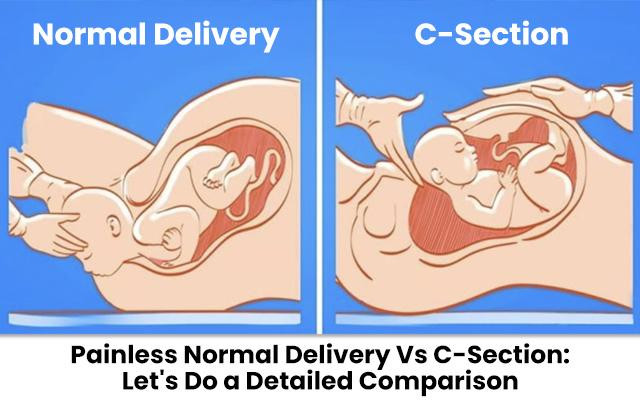Welcoming a baby into the world is a transformative experience, and choosing the right delivery method is a crucial decision for expecting mothers. Many women wonder whether a painless normal delivery or a C-section is the better option. Each method has its own benefits and risks, and the decision should be based on factors such as maternal health, the baby’s position, and any potential complications.
What Is Painless Normal Delivery?
A painless normal delivery is a vaginal birth in which epidural anesthesia is used to alleviate labor pain. The process follows a traditional vaginal delivery, but the administration of an epidural reduces discomfort significantly.
Pros of Painless Normal Delivery
-
Faster Recovery: Women who opt for a vaginal birth typically recover quicker and resume daily activities sooner.
-
Lower Risk of Complications: Compared to surgery, normal delivery has a lower risk of infections and blood clots.
-
Health Benefits for the Baby: Babies born vaginally receive beneficial bacteria that support their immune system.
-
No Surgical Intervention: Since there’s no incision, risks associated with anesthesia and surgery are minimized.
Cons of Painless Normal Delivery
-
Labor Pain Before Epidural: Contractions can be painful before the epidural is administered.
-
Not Always Feasible: If complications arise, a normal delivery may not be a safe option.
-
Risk of Perineal Tears: Some women may experience vaginal tears during delivery.
What Is a C-Section?
A Cesarean section (C-section) is a surgical procedure in which the baby is delivered through an incision made in the mother’s abdomen and uterus. It may be planned due to medical reasons or performed as an emergency measure if complications occur during labor.
Pros of C-Section
-
No Pain During Delivery: The procedure is done under anesthesia, eliminating pain during birth.
-
Predictability: A scheduled C-section allows parents to plan ahead without labor-related unpredictability.
-
Safer for High-Risk Cases: If the mother has medical conditions such as hypertension, placenta previa, or a narrow pelvis, a C-section ensures a controlled and safe birth.
Cons of C-Section
-
Longer Recovery Period: Being a major surgery, recovery takes longer and involves post-surgical discomfort.
-
Increased Risk of Infection: C-sections have a higher risk of complications like infections, blood clots, or adverse reactions to anesthesia.
-
Potential Future Pregnancy Risks: Multiple C-sections can increase the risk of complications like placenta previa or uterine rupture in future pregnancies.
Which One Should You Choose?
The choice between a painless normal delivery and a C-section depends on your overall health, pregnancy condition, and medical history. If you're in Kolkata, consulting the best gynecologist in Kolkata will help you evaluate factors such as:
-
The baby’s position (head-down or breech)
-
The baby’s size in relation to the mother’s pelvis
-
Maternal health conditions (gestational diabetes, high blood pressure, etc.)
-
Previous birth history (vaginal or C-section delivery)
For mothers with a low-risk pregnancy, a painless normal delivery is generally preferred due to its natural process and quicker recovery. However, if complications are present, a C-section may be the safer choice.
Conclusion
Both painless normal delivery and C-sections have their advantages and risks. The key is to seek advice from an experienced gynecologist in Kolkata, such as Dr. Pallab Roy, to determine the safest option for you and your baby. Ultimately, the priority is ensuring the health and well-being of both mother and child.
If you’re expecting and need expert guidance, book a consultation today with a trusted specialist to make an informed decision for a safe and smooth delivery.

